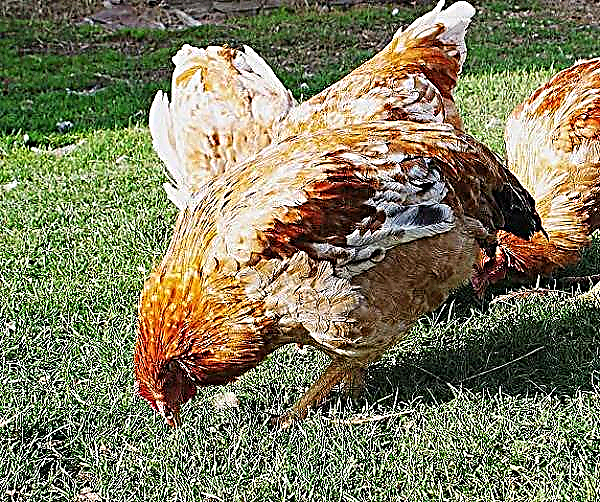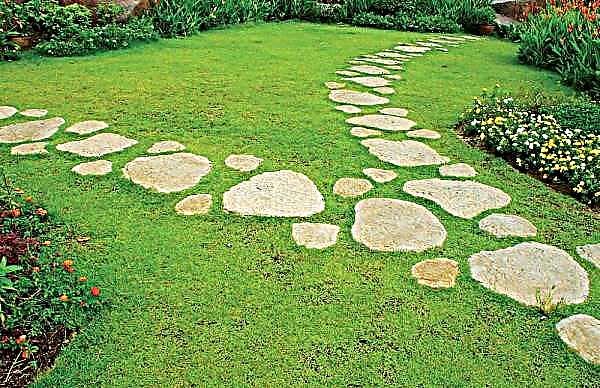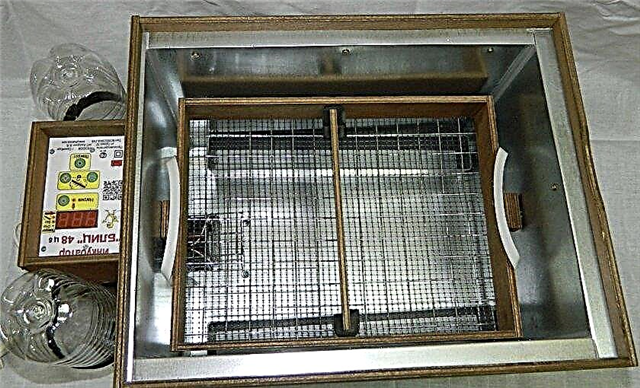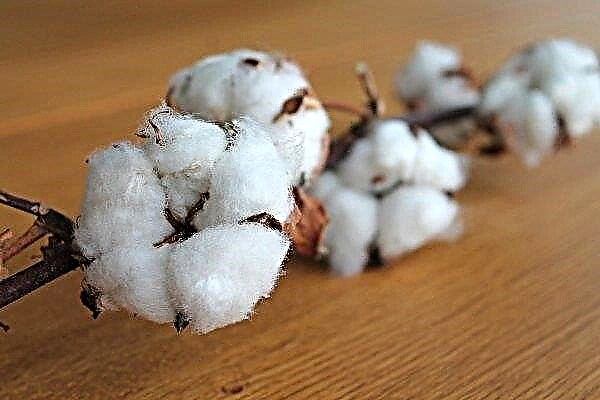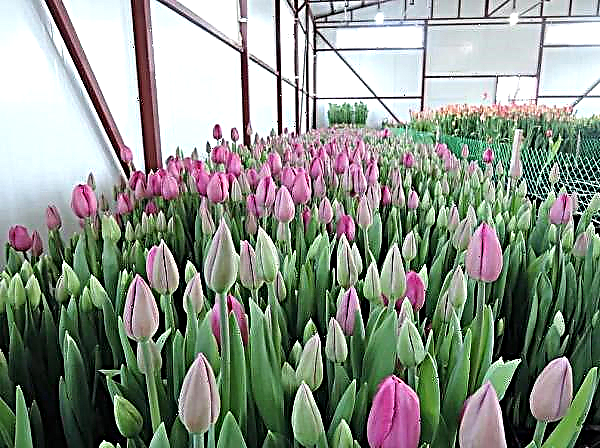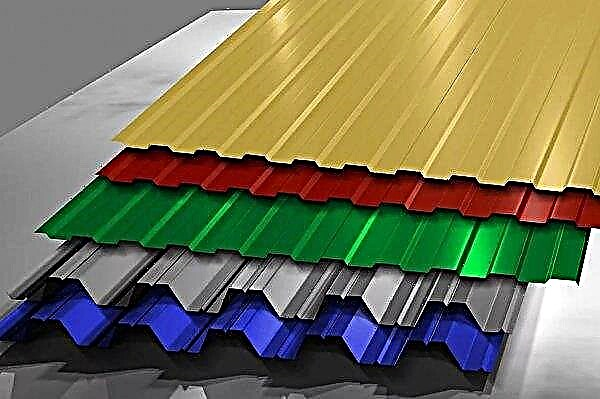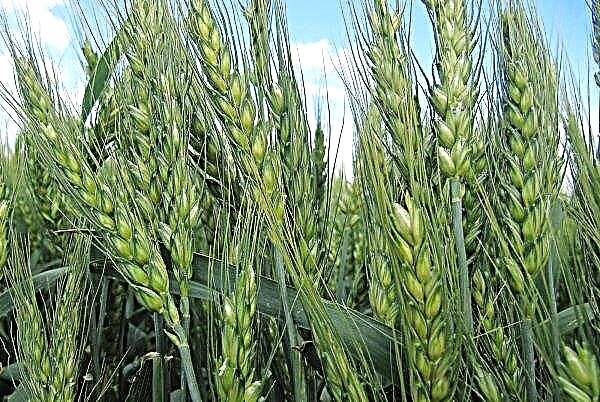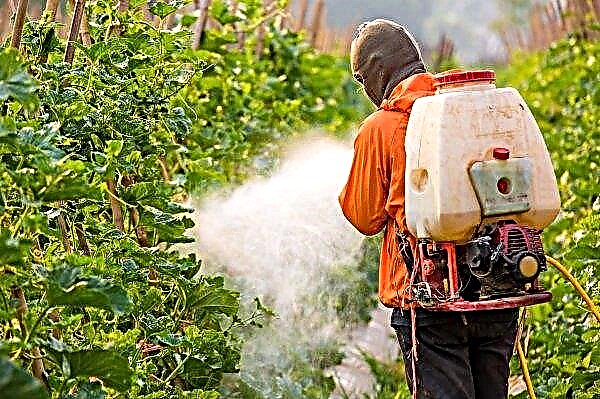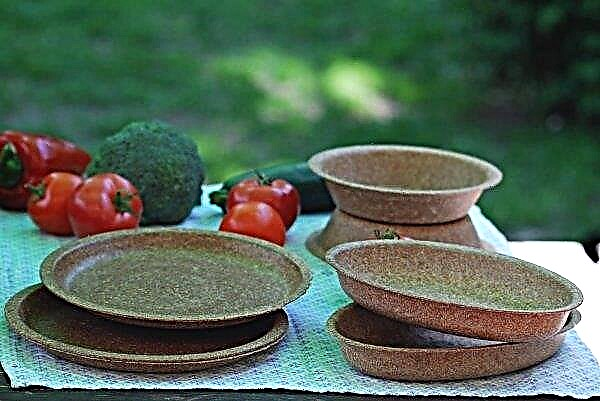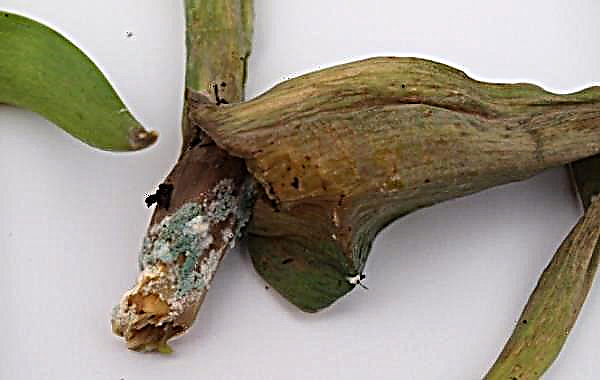Ehmeya is a perennial herb that is found at home in many gardeners due to its attractive appearance. But for all its beauty, many of the species are poisonous. That is why it is important to know some features in their maintenance and care.
Botanical description of the plant
Echmea refers to epiphytes - plants that settle on other representatives of the flora. But she does not parasitize on them, but feeds on her own. Sometimes it is ground. In nature, such a flower can grow up to 200 cm in height. Indoor specimens do not exceed the mark of 90 cm. Some may be only 30 cm high. Foliage length is 20-50 cm.
Did you know? Latin name ehmei — Aechmea — arose from the ancient Greek word aechme, meaning "tip of the peaks." Most likely, this name of the flower is associated with its pointed bract.
Their shape is linear or belt-shaped. The edges are dotted with tiny cloves, and the end is rounded or pointed. Each new leaf grows from a basal rosette in a circle. The center of this outlet is a funnel. The color of the foliage is dark green, with a chaotic pattern consisting of stripes and spots. Typically, an ornament has a transverse arrangement.
Ehmeya feeds through foliage, because its root system is poorly developed and is intended more for fastening.Ehmeya blooms for a long time, but for each flower this happens only once in a lifetime. The first buds often appear in May, and disappear only by October. As soon as the plant fades, the rosette dies, but until this moment a “baby” (lateral process) has time to appear, which must be planted in time. But this procedure is not carried out immediately after the end of the flowering period, but only when the shoot is half the size of the mother plant.
Important! Ehmei juice is poisonous, so you need to contact it only with rubber gloves. The fruits are forbidden.
Flowering begins with the appearance of a huge inflorescence on a fleshy peduncle. In shape, it is capitate or spike-like. The buds appear small and often of different colors in one inflorescence. Usually these are shades of pink, purple, blue or lilac. After the flowering period ends, fruit-berries are formed. Ripening, they release the oblong seed.
| Root system | Weak, superficial |
| Stem | Shortened |
| Leaf shape | Linear or belt-shaped |
| Leaf color | Dark green with a pattern |
| Flower shape | Capitate or spike inflorescence |
| Flower color | Pink, purple, blue, lilac |
| Fruit shape | Rounded berry |
| Fruit color | Yellow orange |
Views
The genus Echmea has 283 species. We will give a brief description only to some representatives:
- Ehmey Weilbach. It has a goblet rosette, which is formed by bright green xiphoid leaves. Root inflorescences have a red peduncle and lilac-blue flowers. It blooms in April-May.
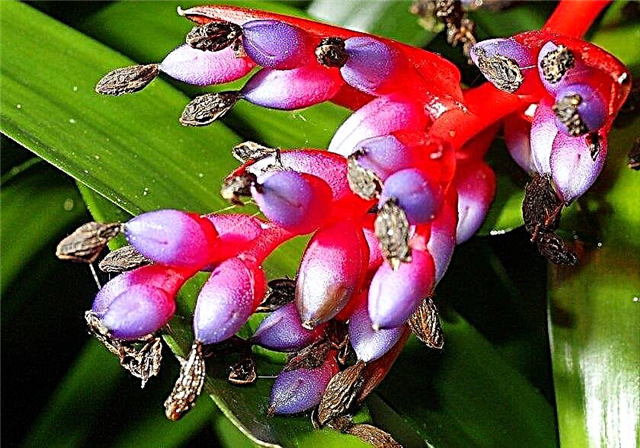
- Two-row. It happens as an epiphyte and a terrestrial plant. Its basal rosette is about a meter in diameter. The leaves in it are not very densely arranged. Their color is green with dark brown spikes along the contour. The leaves are narrow, grow up to half a meter with a width of only 3 cm. Bracts are bright red, and the petals are lilac.

- Curved. The owner of narrow and long leaves forming a tube-shaped rosette. Along the contour they are dotted with small spikes. The inflorescences are curved in shape with bright red petals and bracts.
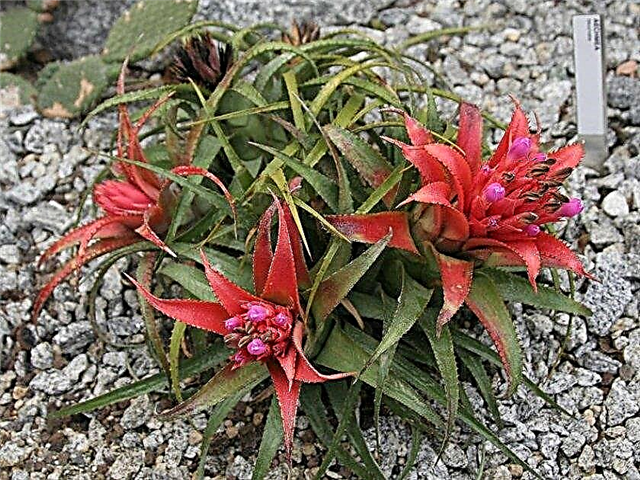
- Shaggy. She is also called lindela. The foliage of this flower is very long, often up to 100 cm, along the edges in small cloves. Leaves grow from the outlet densely. The first buds appear in the winter. They are painted bright yellow, with red bracts. The inflorescence is a multi-row spike.

- Matt red. It is considered the most hardy and most adapted to home conditions of the whole family. Long, up to half a meter, leaves form a dense, funnel-shaped rosette. Each leaf resembles a tongue narrowed at the base. Their color is unusual. The outer side is light green, and the back with a purple hue. Flowering begins with the appearance of a pyramidal inflorescence, decorated with flowers with light blue petals and a matte red sepals. If pollination occurs, then bright pink fruits will ensue.

- Striped It has dense belt-shaped leaves that form a tubular outlet. The color of the foliage is green. Their contour is studded with small cloves. The end is decorated with a thorn. The length of the leaves is 0.4–0.5 m with a width of 5 cm. This type of echmea can produce an inflorescence about 30 cm long. In shape, it is capitate-pyramidal. Bracts are pink with a glossy surface. As soon as the flower opens, a bluish tint is present in the color of its petals. Over time, they acquire a blue-red color.

- Sparkling. The difference between this type of echmea from others is a loose rosette formed of pale green foliage with a grayish coating. Leaf length - 40 cm, width - 4-6 cm. At the apex, it is rounded, and along the contour - in rare teeth. During flowering, forms several inflorescences with red, coral flowers with a slightly bluish edge. Bracts are pink.

Conditions for successful growing at home
To make a tropical flower away from the homeland feel comfortable, it is necessary to create certain conditions for it.
Lighting
A plant loves light, but if you place it in a slightly shaded place, then its color will not change much. The ideal place for it would be east and west windows. But there are some nuances.
Different species react differently to light, so to understand where to place the flower, you need to look at its foliage. Species with hard sinewy foliage need intensive lighting, but without direct sunlight. Those species that have soft foliage, it is better to put in partial shade.
Ventilation
Where the ehmeya is located, the air should always be clean and fresh, so the room should be regularly ventilated.
Temperature
A decorative flower loves warmth. When it begins to bloom, the temperature in the room should not fall below + 23 ° C. When the buds open, you can slightly lower the thermometer to +15 ... + 21 ° C. In winter, a suitable temperature should be in the range +12 ... + 18 ° С.
Important! It is impossible to sharply lower or raise the temperature. This flower is very sensitive to temperature spikes.
Air humidity
The plant may normally exist in a room with dry air, but in order to enjoy the riot of colors of echmean flowers, it is better that the humidity is moderate. To maintain it at the proper level, you need to carry out daily spraying of the flower.
Home Care
The indoor flower of ehmei is not particularly demanding in care, but still a minimum of useful actions aimed at maintaining its growth and development must be performed.

Watering
Due to the fact that echmea draws all nutrients through the leaves, the main thing for it in watering is the presence of water in the outlet. Irrigation of the soil is a minor issue. In the outlet, water should be changed every 2 months. If it empties earlier, then the interval must be shortened.
Irrigation is carried out with soft warm water, as soon as the topsoil dries. In winter, only dried soil is watered. The socket remains empty.
Top dressing
Fertilizers are actively applied only in the warm season. The feeding interval should be 2-3 weeks. You can use mineral complexes for flowering indoor plants, but it will be more useful to purchase special mixtures intended for representatives of the bromeliad family. When using standard fertilizers, the dosage should be reduced by half.
Pruning
The flower does not need pruning. Only a wilted outlet after flowering is cut off. Sometimes, if the peduncle itself has not fallen off, then you need to cut it. Leaves are cut off only dead.
Transfer
Usually ehmeya replant in the spring, as soon as its roots fill the pot. The new capacity is selected in accordance with the size of the flower. Its bottom is lined with drainage, and on top it is filled with a substrate for the bromeliads or with a mixture of peat, turf, leafy soil and humus taken in equal parts. It will be useful to add a small amount of sand or perlite to the mixture.
To release the flower from the pot, the soil must be abundantly watered. Then, a little tapping on the pot, gently extract the flower. Using a stick, the root system is freed from the old earth, and the plant is immersed in a new pot. Sprinkle with fresh soil on top. In a new place, ehmey is not watered for 2 days. At this time, it must be put in a dark place.
Video: How to transplant ehmeya
Breeding
The tropical beauty propagates by “children” and seeds. Both options are practical, but a flower grown from a seed can bloom only after 3-4 years.
Did you know? Family Bromeliad, to which Echmea belongs, has about 40 genera and 1600 species. The most famous member of this family is pineapple.
Scions
For cultivation by processes, the “baby” must be with roots. The procedure is carried out in March.
During it, you should perform the following actions:
- Carefully remove the adult plant from the pot.
- With a sharp knife, separate the lateral processes with roots. Sprinkle the cut with crushed activated carbon.
- Take a pot with a diameter of 70–90 mm and fill it with a substrate (sheet soil, peat, sand (2: 1: 1)).
- Plant the shoots in a container and cover them with a cropped plastic bottle or glass.
- Place the seedlings in a warm, well-lit area.
- With the advent of new leaves, transplant into large pots.

Seeds
Sowing seeds is also carried out in March. They are recommended to be sown in peaty friable substrate or crushed fern roots. Crops are covered with a film and placed in heat (+23 ... + 26 ° С). Direct rays of the sun should not fall on the greenhouse. Every day, for about 10 minutes, the film must be removed so that the seedlings are ventilated. With the appearance of 1-2 leaves, they are picked into individual pots.
Possible growing difficulties
Among the problems that flower growers usually encounter when breeding ehmei, the first place is occupied by the lack of flowering. Next are diseases and pests. We will discuss how to cope with these misfortunes and prevent their occurrence.
Why does not bloom
Usually, the echmea does not bloom due to the fact that the rules for caring for it are not followed: the temperature is inappropriate, the air in the room has not been updated for a long time, or the substrate is wet. These shortcomings can be quickly corrected. But it so happens that there is no flowering with proper care.
In this case, do the following: place apples near the plant. They are able to emit ethylene, which contributes to the activation of the growth and maturation process. To maximize the effect, you should cover the flower and fruits with a plastic bag and leave for two weeks. After that, in the next 3-4 months, one should expect the appearance of flowers.
Diseases and Pests
The most common diseases and pests are:
- Root rot. Appears due to waterlogging of the soil. It provokes a change in the color of the leaves to yellow and its withering. It is possible to cope with misfortune only at an early stage. It is necessary to cut off the darkened roots and the affected foliage and plant the plant in a new substrate, treating it with a fungicide (for example, “Carbendazim”).
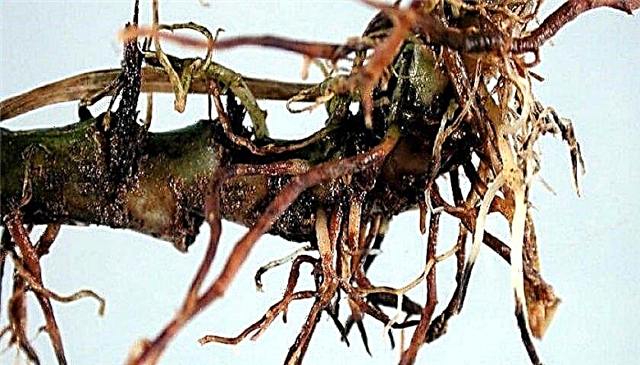
- Sooty mushroom. It appears in the form of a continuous film on leaf blades and stem. Because of this plaque, photosynthesis worsens, and the plant begins to wither. The disease usually indicates the presence of pests such as scale insects, aphids, and worms, so first you need to remove the pests, and then rinse the leaves with clean water.
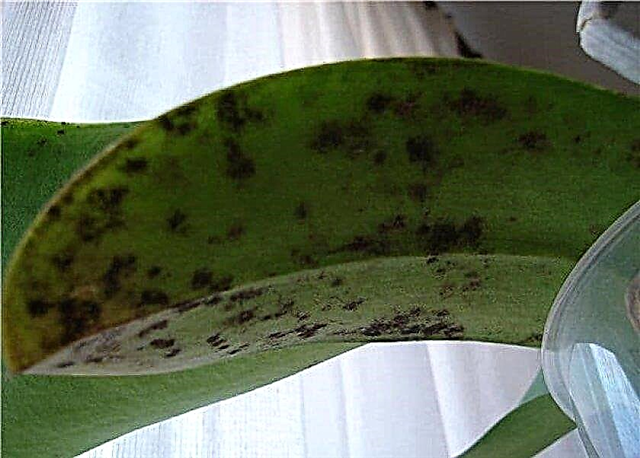
- Shield. Attacks the leaves of echmea. Under their influence, they curl, turn yellow and die. The flower itself slows down growth. The pest is manifested by brown plaques located along the veins on the back of the leaf blade. In addition, a sticky substance appears on the leaves and shoots. If the pest has just appeared, then it can be removed using a cotton swab dipped in alcohol or a soap solution. When there are a lot of insects, then you have to use insecticides, for example, “Karbofos” or “Actellik” (15-20 drops per 1 liter of water).
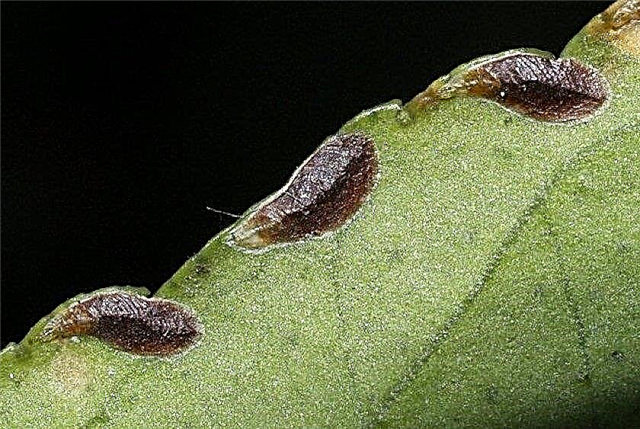
- Spider mite. Its appearance is evidenced by a thin, slightly noticeable cobweb on the flower. The leaves are covered with brown spots, due to which they subsequently turn yellow and die. Compliance with the norms of humidity will help prevent the appearance of the tick, and insecticides are able to overcome it: Decis, Fosbetsid (0.03-0.05%).
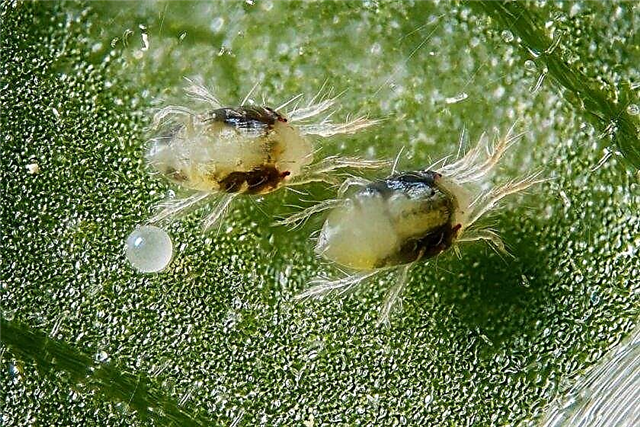
- Mealybug. He settles on the ehme, greatly spoiling its decorativeness. You can remove it with a soap solution or alcohol. They need to wipe the foliage. If there are a lot of insects, then the flower should be treated with “Karbofos”.
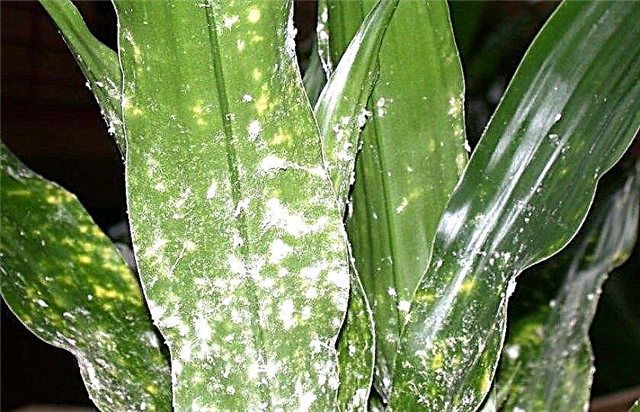
- Root worm. Unlike its "brother", it affects the underground part of the plant, which leads to its decay. It is necessary to reduce watering and treat with 0.3% Karbofos solution or 0.3% Fozalon solution.
Important! If, due to the attack of the root worm, the underground part of the echmea is badly damaged, then it is unlikely to save the plant. In this case, it is better to dispose of it.
Omens and superstition
According to popular beliefs, echmea cleanses the house of negative energy. This flower helps people become more purposeful and more active, so it’s better not to keep it in the bedroom, otherwise you will face insomnia. The best place for an ehmeya is a study, where she can influence the success of business negotiations.
Despite the fact that echmea is poisonous, it is a very beautiful flower. If you follow all the precautions when working with him, he will not do harm, but will only delight with a riot of color.













